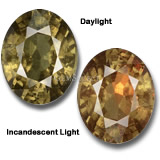Color Change Garnet Gemstone Information

Introduction to Color Change Garnet
Ever seen a gemstone that seems to have a mind of its own, shifting colors like a chameleon? That’s color change garnet for you - a rare and captivating member of the garnet family. Unlike pleochroism, where gems show different colors based on the viewing angle, color change garnet switches hues depending on the light source. Think of it as a gemstone with a built-in light show!
This gem is typically a blend of spessartite and pyrope garnet, sometimes with dashes of grossularite or almandine. The color shift can be jaw-dropping - often more dramatic than top-tier alexandrite. In daylight, you might see brownish-green or bronze tones, but under incandescent light, it transforms to rose or pink. To really get the full experience, check it out under morning light, late afternoon sun, fluorescent bulbs, or even candlelight. Each setting reveals a new side of its personality.
For an introduction to garnet varieties as a whole, visit All About Garnet.
Identifying Color Change Garnet

Garnet comes in two main mineral series: aluminum silicates (pyrope, almandite, spessartite) and calcium silicates (uvarovite, grossularite, andradite). What sets them apart? Subtle differences in color, density, and refractive index. All garnets share a unique crystal structure - a rhombic dodecahedron, which is a fancy way of saying twelve-sided crystals with rhombic faces. It’s like their signature handshake.
Color change garnet is compositionally similar to malaya garnet but stands out due to its hue-shifting ability. To identify it, simply observe it under different light sources. It’s often mistaken for alexandrite, but its hardness (7 to 7.5 on the Mohs scale) sets it apart. Plus, while alexandrite is usually tiny (under half a carat), color change garnet often comes in larger sizes, making it a bold choice for jewelry.
For a detailed overview of garnet gemstones and their varieties, visit our Garnet Gemstone Information page.
Origins and Sources
Garnets form under intense heat and pressure in metamorphic rocks and igneous formations, making them fairly common. But color change garnet? That’s a rare find. East Africa, especially Tanzania’s Umba Valley, is the top supplier. Other key sources include Sri Lanka, Madagascar, Norway, and the USA.
- East Africa: Known for spessartite-grossularite-pyrope mixes, shifting from greenish-yellow to purplish-red.
- Sri Lanka: Produces gems that change from blue, green, or grayish in daylight to reddish-purple under incandescent light.
- Madagascar: Yields top-quality stones from Bekily, transitioning from greenish-brown to red-pink, sometimes with orange hues.
- USA (Idaho): Mostly almandine-pyrope mixes, famous for red to purplish-red shifts.
- Norway: Small but intense crystals, shifting from violet to claret or blue-green.
Each region adds its own flair, making every piece unique. It’s like the gemstone version of a global tour!
Explore other rare and collectible garnets in our Rare Garnets feature.
Buying Guide
Color and Appearance
The hallmark of color change garnet is its ability to shift hues dramatically. The most common transition is red to green - think lush forest green in daylight morphing into a vibrant ruby red under a lamp. Other combos include greenish-yellow to pinkish-red or bluish-green to violet-purple. Under candlelight, some stones take on a deep, blood-like red. It’s like owning multiple gems in one!
Clarity and Luster
Most color change garnets are transparent, though inclusions are common. Eye-clean stones, especially in larger sizes, are rare and highly prized. When polished, these gems boast a vitreous, glass-like luster that catches the eye.
Cut and Shape
To showcase their color-shifting magic, these garnets are typically faceted. Ovals and rounds are popular, but cushions and emerald step-cuts also shine. Fancy shapes like pears or hearts are rarer but make a statement.
Treatments
Good news: color change garnet is typically untreated, so what you see is pure, natural beauty.
Pro Tip: Buy by size, not carat weight, as colored gems vary in density. A larger garnet might weigh less than a diamond of the same size.
If you’re thinking of buying a color-change garnet, see our Garnet Buying Guide for practical shopping tips.
Gemological Properties
| Chemical Formula | [Mg3 + Mn3]Al2(SiO4) - Manganese aluminum silicate |
| Crystal Structure | Cubic - rhombic, tetrahedron |
| Color | Light-bluish, green, purple under white light; light-red to purplish and pink under incandescent light |
| Hardness | 7 to 7.5 on the Mohs scale |
| Refractive Index | 1.73 - 1.81 |
| Density | 3.65 to 4.20 |
| Cleavage | None |
| Transparency | Transparent, translucent, opaque |
| Double Refraction | Normally none |
| Luster | Vitreous |
| Fluorescence | Mostly none |
For more gemology terms, check out our Garnet Gemstone Information page.
Related Gemstones
Garnet is a diverse family, with six main mineral species: pyrope, almandite, spessartite, uvarovite, grossularite, and andradite. Beyond the classic red, garnets come in green, blue, brown, pink, and purple. Color change garnet often gets confused with chrysoberyl, alexandrite, tourmaline, or sapphire due to its vibrant hues. But its unique crystal structure and color-shifting ability make it stand out.
Garnets rarely form in pure mineral types, often blending multiple species, which adds to their variety and charm.
Mythology and Metaphysical Properties
The name “garnet” comes from the Latin “garanatus,” meaning “seed-like,” inspired by pomegranate seeds. For thousands of years, garnets have held cultural significance. Ancient Greeks believed they protected children from drowning and countered poison. In the Koran, garnet lights up the fourth heaven. Both Hebrew and Christian texts mention garnet in Aaron’s breastplate, and legend says Noah used a garnet lantern to navigate his ark.
Known as a traveler’s stone, garnet was a talisman for explorers, believed to ward off evil and illuminate the night. It’s also tied to emotional healing, lifting depression and banishing bad dreams. Physically, it’s thought to help with arthritis, varicose veins, and more. As the birthstone for January and the stone for Aquarius, it’s also linked to Mars, Mercury, and Pluto.
Learn more about the symbolism and spiritual properties of garnet in our Garnet Meaning and Powers article.
Jewelry Design Ideas
With its durability (7-7.5 on the Mohs scale) and stunning color shifts, color change garnet is a jewelry designer’s dream. It’s perfect for rings, necklaces, bracelets, and more, offering both brilliance and affordability compared to other gems. Its rarity makes it a favorite for high-end, unique pieces rather than mass-market designs.
As a January birthstone, it’s a popular choice for personalized jewelry. Whether set in a sleek modern pendant or an intricate vintage ring, this gem always steals the show.
Care and Cleaning

Keeping your color change garnet sparkling is easy. Use warm water, mild soap, and a soft cloth or brush. Rinse thoroughly to remove any soap residue. Avoid extreme heat, as sudden temperature changes can cause fractures. Ultrasonic cleaners are generally safe but use with caution, and steer clear of steamers or harsh chemicals like bleach, which can corrode the stone.
Remove jewelry before sports or heavy activity to protect the settings. Store your garnet wrapped in a soft cloth or in a fabric-lined box to keep it scratch-free.

